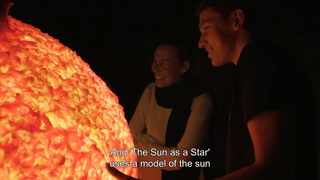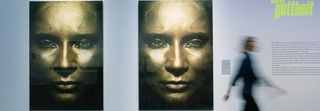The Dresden "Solar Mission"
…3…2…1… In late summer 2018 NASA’s Parker Solar Probe blasted off on a historic mission. Its aim is to get closer to the S than ever before. Shortly afterwards the Deutsches Hygiene-Museum launched a mission of its own: a large-scale special exhibition exploring the Sun from all sides. So welcome aboard as we find out more about the cultural significance, scientific findings and some unsolved mysteries surrounding the star around which everything on Earth revolves — and find out more about us human beings, too. How did ancient civilisations on all five continents view the Sun? What can solar science today tell us about the composition of our star? And what influence does the Sun have on today’s society, our well-being, and our everyday lives?The first thing you encounter as you enter the exhibition is a large-scale art installation inspired by space travel’s century-old dream of one day reaching the sun. From there you gravitate along seven ‘orbits’ examining the Sun from various perspectives: the Sun as a deity and a timekeeper, as a symbol, a luminous force, a remedy, an energy source, and of course as a star at the centre of our universe. The themes of the exhibition range from worship rituals in Ancient Egypt, alchemy and astrology to solar farms and space probes to bikinis, bombs, and pop music classics. Each section comprises hands-on research stations with an opportunity to look deeper into what makes the Sun so fascinating and allow you to reach your own surprising conclusions. Here comes the sun!
Exhibition trailer (German with English subs)
Wenn Sie dieses Video abspielen, werden Informationen über Ihre Nutzung an den Betreiber des Videos (YouTube) übertragen und unter Umständen gespeichert.

Artists
Josef Albers, Martin Andersen, Silvia und Gerry Anderson, Isaac Asimov, Eugène Atget, Ingeborg Bachmann, Frédéric Auguste Bartholdi, Georges Bataille, Hans Sebald Beham, Oliver van den Berg, Joseph Beuys, Alice Boughton, Margaret Bourke-White, George Brecht, Barbara Breitenfellner, Burton Nitta (Michael Burton and Michiko Nitta), Tommaso Campanella, Thue Christiansen, Antonio Corradini, Harry Crosby, Hari Sadhan Dasgupta, Johann Melchior Dinglinger, Tommy Dorsey and His Sentimentalists, Albrecht Dürer, Charles und Ray Eames, Mona Eldaief, Ben Enwonwu, Richard Buckminster Fuller, André Gelpke, Hendrick Goltzius, Robert Gommlich, Aneta Grzeszykowska, Werner Herzog, Ho Rui An, Billie Holiday, Bodin Hon, Stephan Hüsch, Athanasius Kircher, Philipp Khabo Koepsell, Knut Kruppa, Alicja Kwade, Mike Leigh, Zoe Leonard, Ted Lewis, Leo Lionni, El Lissitzky, Herbert List, Jayne Loader, Colin Low, Auguste Lumière, Louis Lumière, Lydia Mall, Vitaly Mansky, Siobhán McDonald, Georges Méliès, Erich Mendelsohn, Elena Mitrofanova und Ivan Mitrofanov, Masaaki Miyazawa, Friedrich Wilhelm Murnau, Ikko Narahara, Trevor Nickolls, Friedrich Nietzsche, Jahane Noujaim, Pete Standing Alone, Otto Piene, Walid Raad, Kevin Rafferty, Pierce Rafferty, Man Ray, Miguel Rothschild, Susan Schuppli, Fazal Sheikh, Katharina Sieverding, Frank Sinatra, Sun Ra, Alphonse Swinehart, Marina Toeters, Panos Tsagaris, Wang Fu, Wladimir Wassiljew, Eyal Weizman, Dhukal Wirrpanda and others
Research stations
Explore the sun: Each section of the exhibition has its own research station where children and adults alike can take a closer look at the Sun's mysteries. In the 'Sun as a Deity' section, say, visitors with creative talents can design their own sun god or dress up like the Sun King Louis XIV in the 'Sun as a Symbol' section. The sections on the Sun as a luminous force, remedy, energy source and star similarly provide experimental opportunities for exploring key questions: how is the Sun's core structured? In what instances are the Sun's rays good for our body and when are they harmful? What forms of solar energy are there, and how much energy does one household use?
The seven "Orbits"
"Always The Sun" – The Sun as a deity
Many civilisations and religions have venerated the Sun's omnipotence: the peoples of Ancient Egypt, Babylonia, Greece, Persia, and Rome, the Aztecs and Mayans in South America, right through to the present day - e.g. in Hinduism, Buddhism, and among First Nation Australians. What needs and fears prompted human beings across the millennia to turn to their own particular solar deities? What are the kinships and the differences between them?
"Waiting for the Sun" – The Sun as a Timekeeper
The Sun provides us with a means of orientation in time. Its appearance defines the time of day and the seasons, much in the same way as our ‘biological clock’ defines our sleeping and waking hours, like all living creatures. But how do day and night, and the seasons occur? What sort of influence has this defining function had on the evolution of human beings and their cultures from the dawn of civilisation through to our high-tech society?
"Walking On Sunshine" – The Sun as a Symbol
For people across the world the Sun has long embodied ideals such as freedom, eternity, illumination, creative power, justice, and above all absolute power. Its imagery has been drawn upon by all manner of different personalities ranging from the Sun King Louis XIV, the dictator Adolf Hitler and the Japanese Emperor Hirohito to the freedom fighter Mahatma Gandhi, and even the pop icon Beyoncé. Many utopian movements have looked to the Sun as a symbol of an enlightened, more humane civilisation. The exhibition aims to decipher the Sun’s complex and at times contradictory symbolism.
"I’ll Follow the Sun" – The Sun as a luminous force
The Sun is so radiant, powerful and sublime that it is capable of eliciting intense and existential emotions within us. This sense of wonder has been the focus of attention time and again from Antiquity through the age of Romanticism to the post-modern era. Yet there is more to it than a sense of awe. Indeed, beside the emotive impact, the Sun’s illuminating power has a highly practical aspect, too: it provides human beings and animals alike with a means of communication and orientation.
"Blister In The Sun" – The Sun as a Remedy
There is a close correlation between the Sun and our physical and mental wellbeing. For the Sun is able to both heal and prevent illnesses. But here, once again, the Sun’s ambivalent nature comes to the fore. Whereas too little sunshine can induce illnesses such as rickets or depression, too much of it can cause skin cancer. To what extent should we expose our bodies to the Sun, and how should we go about protecting ourselves from it? How does that influence architecture, fashion and design?
"I Won’t Let The Sun Go Down On Me" – The Sun as an Energy Source
As human beings we have always sought to harness the power of sunlight for our own purposes, using all sorts of technologies. The trend itself gained ever greater momentum with the discovery of nuclear power in the early twentieth century. From current developments in photovoltaics to the use of solar fuels, solar energy is now one of the most important sources of innovation. In what ways will the Sun contribute to solving the burgeoning global energy crisis?
"Shine On You Crazy Diamond" – The Sun as a Star
It took us thousands of years to understand that the Sun is not a planet, but a star, and that our little planet Earth revolves around it. Today, solar science knows a good deal more about the Sun, but by no means everything: we know that it is made up of the same matter as the Earth, and that both probably have the same origin; that momentous cycles of solar activity originate inside the Sun, each one lasting around eleven years, that these cosmic magnetic fields have a direct impact on our climate and our weather; that the Sun is currently half way through its life and is expected to glow for ‘just’ another five billion years. So has the erstwhile protean deity become a mere physical phenomenon? Can our more accurate understanding of the Sun help us shape our everyday lives with greater certainty about the future or perhaps halt climate change? What findings can we expect from the mission to the Sun that NASA launched in August 2018?
Funders


